From the breath-taking Blue Mosque to the mythical city of Troy, the country of Turkey has more than its fair share of iconic landmarks and monuments. Sprinkled with ancient ruins, unusual underground caverns and bustling bazaars, there are so many famous places that we just had to count them down. So, with the help of some of the globe’s best travel writers, here is our rundown of the 25 most legendary landmarks in Turkey!

Skip ahead
Our 10 top must-see landmarks in Turkey
- Hagia Sophia
- Pamukkale
- Sumela Monastery
- The Blue Mosque
- Mount Nemrut
- Topkapi Palace
- Anikabir
- Ani
- Goreme National Park
- Aspendos
Hagia Sophia, Istanbul
Explored by James from The Travel Scribes

Undoubtedly one of the most recognisable sights in Turkey, if not the world, the alluring exterior of the Hagia Sophia is only rivalled by its incredible interior and design.
Originally built in 537 as the cathedral for Constantinople, the imperial capital, the Hagia Sophia (which means ‘holy wisdom’ in Greek) was the largest Christian church in the Byzantine Empire, the pinnacle of power for the eastern Roman empire. However, it was in 1453, after the Ottoman Empire secured Constantinople, that it was transformed into a mosque, and later a museum.
With its dome dominating Istanbul’s skyline, this UNESCO World Heritage site is also the nation’s biggest tourist draw, something under threat since 2018, when ruling President Erdogan ordered it to change back to a mosque and shutting out many of its international visitors.
Regardless of its tourist status, the Hagia Sophia is still one of Turkey’s most famous landmarks. One of the greatest examples of Byzantine architecture, it was the world’s largest cathedral until the Seville Cathedral, a Spanish landmark in its own right, was built. But it isn’t just the commanding architecture that is worth seeing – the interior is richly decorated with mosaics and marble, an electric mix of Islamic and Christian motifs that you must see once in your lifetime.
Myra Ruins, Antalya
Explored by Thea from Zen Travellers

While they may not be Turkey’s most famous historical monuments, the Myra ruins in the Antalya province are well worth a visit. Located along the Mediterranean coast in the town now called Demre, the Myra ruins date back to the 4th century BC. This archaeological wonder features two necropolis of extensive rock-cut tombs, a sprawling ancient theatre, and impressive stone face carvings built into a stunning mountainside. Legend dictates that the tombs were carved into hills so that the spirits of the dead could soar into the afterlife from their elevated perch like a bird.
In addition to the Myra ruins, the Basilica in Demre is also home to the original 6th century tomb of Saint Nicholas, that is the real human Saint Nicholas, not to be confused with the red-pyjama wearing jolly Saint Nick who delivers Christmas presents. A visit to the Basilica highlights the fascinating history of the region as well as the diversity of architecture that was used over the centuries.
Demre can be easily reached by bus from Antalya or Kas, or by foot along the Lycian Way hiking trail.
Be sure to enjoy some locally grown fresh-squeezed orange juice and pomegranates to re-energize after all your exploring!
Pamukkale
Explored by Claire from Stoked to Travel

The spectacular natural wonder of Pamukkale is located in South West Turkey and is unlike anywhere else in the world.
Pamukkale means ‘cotton castle’ in Turkish, which is one way to describe these unusual white terraced pools that are nestled into the hillside. No-one fully knows how the pools were created, but one widely accepted explanation is the they are formed by a carbonate mineral left by the flowing water. Pamukkale, now a UNESCO World Heritage Site, sits above the rest of the region offering staggering views from the top-level pools. You can climb along the pools’ edges, and even take a dip in the turquoise waters.
Once you reach the highest terrace of pools, you actually find yourself at the phenomenal Greco-Roman ancient ruins at Hierapolis. This vast amphitheatre has been wonderfully preserved and offers exceptional views across the whole region. You can also visit the adjacent hot springs called the Cleopatra Pools, which are popular with locals who come to spend the day there with a picnic.
To get to Pamukkale and Hierapolis, you must first arrive in the large city of Denizli. From here, you can take a minibus directly to the small tourist town of Pamukkale. Although it is possible to visit for the day, I recommend planning to stay for one night, so you can either get to the pools early in the morning before the crowds arrive or stay late for sunset once they’ve left again.
Sumela Monastery
Explored by James from The Travel Scribes
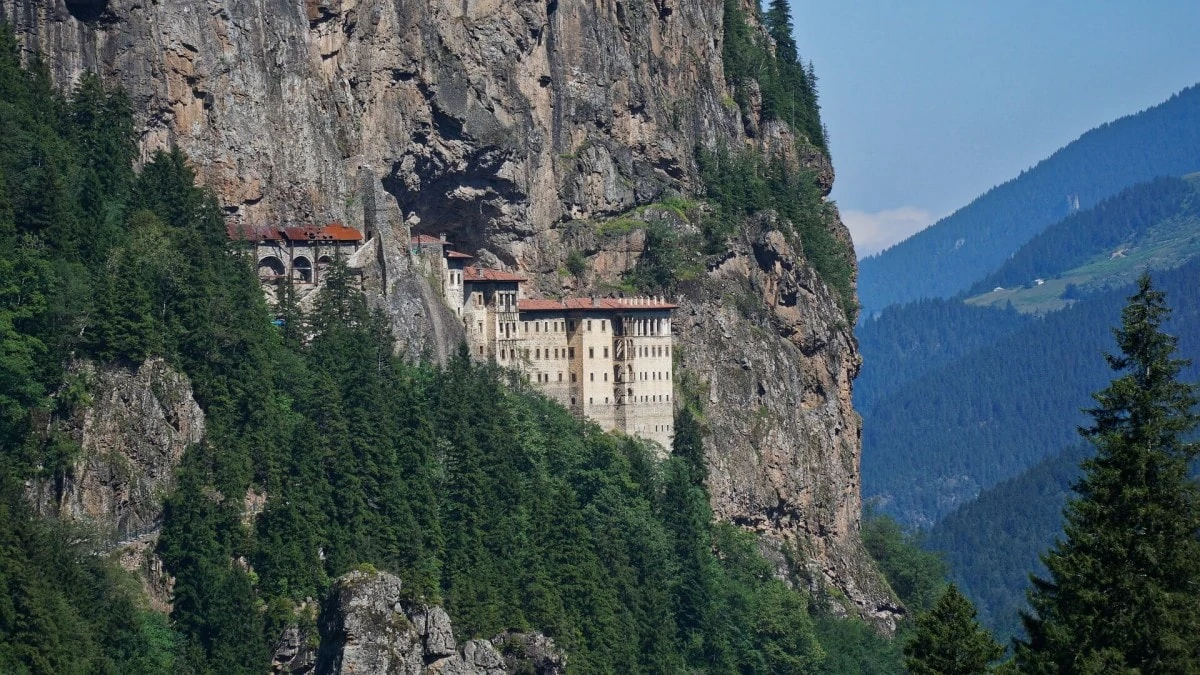
Clinging almost unbelievably from a sheer cliff face, the Sumela Monastery is a sight to behold, and definitely one of the most famous landmarks in Turkey.
While the exact date of its founding is unknown, it’s thought to have been constructed around AD 386, founded by two monks named Sophronios and Barnabas. Why it’s perched on a cliff ledge, no-one knows, but the monastery is located 1,200 off the ground, with sweeping views of the Altindere National Park.
More than just a monastery, there is actually a small village nestled there, including the Rock Church, kitchens, a library and a number of chapels. If you do end up exploring there, there is also a nearby waterfall and some great viewpoints, best visited through a bit of a strenuous walk of 3km.
The Blue Mosque, Istanbul
Explored by Tegan & Alex from Why Not Walk

The Sultan Ahmed Mosque in Istanbul, Turkey, known to some as the Blue Mosque for its iridescent blue tiles, is an Ottoman-era Mosque dating back to the early 1600s. While a fully functioning mosque and madrasah today, it is also a popular tourist destination that is sure to dazzle worshippers and visitors alike.
Incorporating many elements of the Byzantine design seen in the neighbouring Hagia Sophia, the Sultan Ahmed boasts five large domes and six minarets – a truly remarkable (and enormous!) construction. While inside, spend some time gazing up at the intricate domed ceiling, with its famed stained-glass windows, one-of-a-kind handmade Iznik tiles, and ornately calligraphed verses from the Qur’an. The mihrab, or niche representing which direction prayers toward Mecca should be directed, is made of gorgeous marble and also has very detailed inscriptions to admire.
A few practical tips: women must ensure their hair is fully covered prior to entry. It is a good idea to keep a scarf in your daypack anywhere you go in Turkey, to ensure you are able to enter mosques and other religious attractions. In further standard mosque procedure, you must remove your shoes upon entry, and you are loaned slippers to wear while you are inside. While you are allowed to take photos inside, be respectful and quiet, and avoid visiting around the 5 daily prayer times, as it is closed to visitors during those times.
Admission is free and be sure to enter through the visitor entrance rather than the entrance for worship. Keep in mind that the mosque can get very crowded: it is one of Istanbul’s top tourist destinations for good reason! We recommend visiting in the morning, as early as you can, to make the most of your visit.
Mount Nemrut
Explored by James from The Travel Scribes
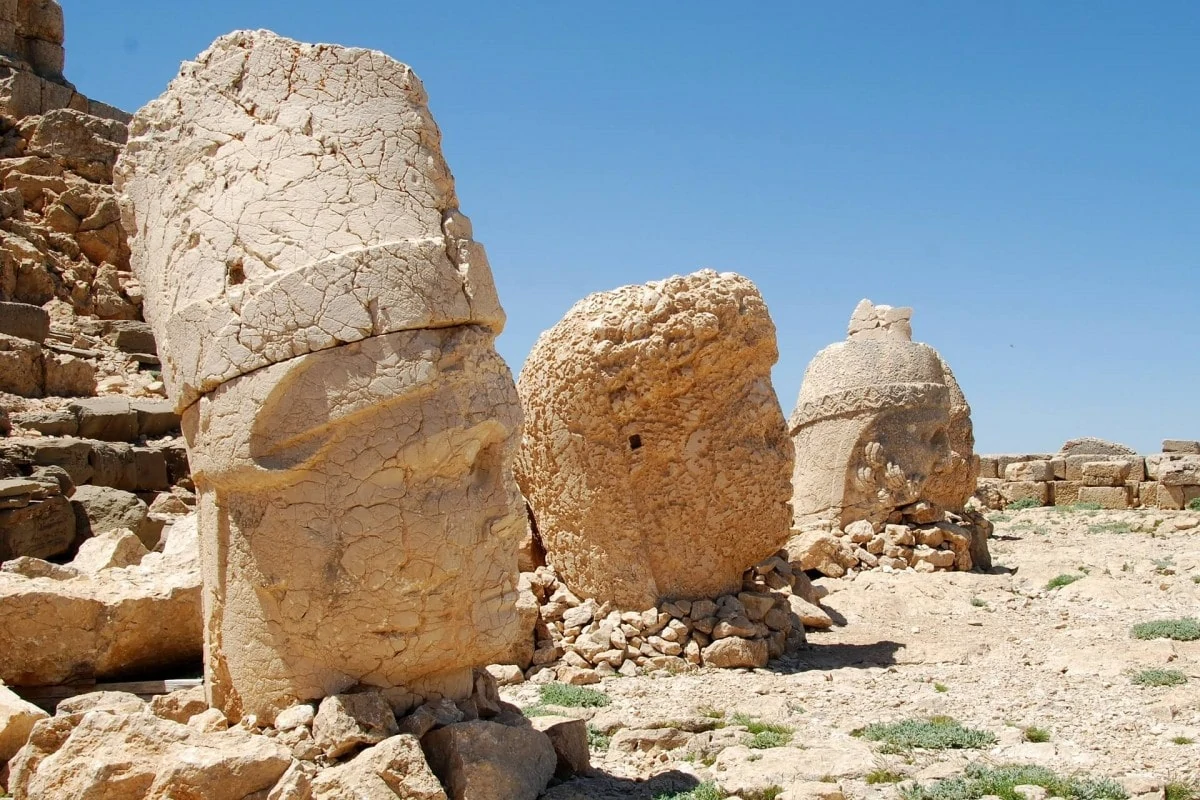
Another incredible sight in Turkey is definitely the lofty summit of Mount Nemrut. This over 2,000-metre-high mountain situated in southeast Turkey is not just one of the tallest peaks in the Taurus Mountains but has a pretty unusual landmark atop it: the statues and burial mound of King Antiochius I.
It’s said that his tomb is buried far beneath the mound, although comprehensive archaeological digs have never found it. That said, this mound is still a huge tourist attraction, for the odd statues that are sprinkled across its surface. Including statues of himself, as well as a number of gods, lions and eagles, what makes the location unique is that the heads have been severed from the bodies and placed across the vista. It’s almost otherworldly to see Antiochus’ head rising from the dust, a sight that has tourists thronging to the mountain.
Best visited at sunrise to see the rays peek out from behind the statues, make sure you don’t visit Mount Nemrut in winter, since heavy snowfall usually makes the summit impassable.
Topkapi Palace, Istanbul
Explored by Larch from The Silver Nomad

Step through the commanding gates of the Topkapi Palace in Istanbul for an intriguing look at the luxurious life of the Ottoman Empire.
Topkapi Palace was the main residence of the Ottoman Sultans for nearly 400 years from the late 1400s. Since 1924, the palace has been a museum filled with jewellery, china, weaponry and more from the Ottomans.
Many of the items were made on the palace grounds by artisans, others were gifts from visiting dignitaries or spoils of war. Some of the porcelain comes from China and Japan and shows just how far the Ottomans travelled. Look out for the Spoonmaker’s Diamond, one of the largest cut diamonds in the world and the stunning emerald encrusted Topkapi Dagger which are in Treasury IV room.
Within the walls, four courtyards beautifully laid out with gardens leading you to the more private areas. In the Ottoman era, the entrance to each was restricted. The fourth courtyard has stunning views over the confluence of the Bosphorus, the Sea of Marmara and the Golden Horn, a perfect vantage point for looking for attacks.
Buy an Istanbul Tourist Pass to get in free to Topkapi Palace and other offers around Istanbul, otherwise, the entrance is 100 Turkish Lira and it is extra to visit the Harem section and the Hagia Irene Church.
However, it’s good to note that the Topkapi Palace is closed on a Tuesday.
Anıtkabir, Ankara
Explored by Kenny from Knycx Journeying

Do you know the capital of Turkey? You may be surprised that most people would think that is Istanbul. In fact, Ankara is the capital city in central Turkey upon the declaration of independence in 1923.
Anıtkabir is the most iconic landmark in the city center. Occupying the top of Observation Hill, it is a mausoleum dedicated to Mustafa Kemal Atatürk, the leader of the Turkish War of Independence, the founder, and first President of the Republic of Turkey.
It is a must-see location in Ankara because of its status and importance. The building is a simple yet impressive, symmetrical cube-shaped monument, facing a ceremonial plaza of over 10,000 square meters – it is a great example of Turkish architecture. Here, the signs and memorials showcase the history of Turkey. Admire the artwork through the Road of Lions, pay respect to Atatürk’s tomb in the Hall of Honor, and take a walk in the Peace Park; if you have time, explore the many towers around the site, and visit the Anıtkabir Atatürk Museum, where you may learn more about history the country’s significant figure, and view many of his personal belongings.
Finally, don’t forget to go behind the mausoleum and have a panoramic view of the city.
Ani, Kars
Explored by Lee from The Travel Scribes

Hugging the eastern border of Turkey is the ghostly town of Ani, a crumbling city that was one a thriving, bustling metropolis.
Known as the ‘city of a thousand and one churches’, Ani was an Armenian medieval city that was the capital of the Bagratid Armenian kingdom and a huge centre for trade and religion. Part of the Silk Road, actually the city was so powerful and prominent that, at its pinnacle, it was one of the world’s largest cities!
Unfortunately, this prominence made it a huge target, as it was the site of skirmishes with the Ottoman Turks, the Kurds, Byzantine emperors and many more. Between these attacks and a devastating earthquake in 1319, the city fell into disrepair and out of favour, declining until it fell into the ruins that it is today.
A UNESCO World Heritage site, Ani can be visited today but does have some restrictions on visitor numbers, so make sure to book any tours in advance.
Goreme National Park
Explored by Campbell & Alya from the Stingy Nomads

Visiting the valleys of Cappadocia located in Göreme National Park is one of the most popular things to do in Turkey.
The water and wind-eroded rock landscapes of Cappadocia is a spectacular UNESCO World Heritage Site covered in unique cone-shaped rock formations called fairy chimneys. This world heritage site has several beautiful open-air museums and underground cities to explore. The landscapes of the open-air museum is a fantastic area to investigate and having a guide hike with you and tell you about the area does enrich the experience.
To explore this amazing part of Cappadocia, stay in the beautiful little town Göreme. A great experience in Cappadocia is to check into one of the cave hotels. The soft volcanic rock of Cappadocia has been hollowed out for homes for more than 2000 years. These ancient houses in Göreme have been restored with modern facilities to form the cave hotels.
A hot air balloon ride over this spectacular landscape must be the most popular bucket list activity in Turkey. Around a hundred hot air balloons take off from Göreme every morning.
When visiting this unique area don’t miss the Goreme Open Air Museum with its cave churches, Zelve Open Air Museum a cave town with churches, the Kaymakli Underground City the largest underground city and Derinkuyu Underground City the deepest underground city. Reaching the Göreme National park is easy with a local flight from Istanbul to Nevşehir-Kapadokya Airport(NEV).
Troy
Explored by James from The Travel Scribes

Photo credit: Espartosa / Flickr
Immortalised in film, the city of Troy is one of the most mythical places in Turkey.
Troy was essentially a city located in the northwest of Asia Minor, in what is now modern Turkey. This ancient city is famous as the place that was conquered by the Greek army, led by the legendary King Agamemnon, as penance for the abduction of Helen, the Queen of Sparta. Homer’s great work, the Iliad, chronicles this siege, all in response to Helen’s abduction by Paris, the son of Troy’s King Priam.
Now known as the hill of Hisarlik, many disputed that the city was actually ‘Troy’ for many years until the 19th century, when excavations at Hisarlik unearthed artefacts and treasures that supported the case.
While there isn’t too much to see nowadays, you can take a trip to Troy (Hisarlik) from Istanbul, although it’s a bit of a long trek.
Bodrum Castle
Explored by Lee from The Travel Scribes

Photo Credit: Claverie / Flickr
Perched on a rocky peninsula on the southwestern coast of Anatolia is the UNESCO World Heritage site of Bodrum Castle.
The Castle, built at the beginning of the 15th century by the Knights of St John (also called the Knights Hospitallers), was not just a fortification but also a refuge for Christians in the region. However, around 1522 it was taken over by the Ottoman Empire, where it was used as a garrison, and the church transformed into a mosque complete with minaret. After changing hands a few more times and again being used as a military base, it was finally made into the Museum of Underwater Archaeology, as it remains today.
Well worth a visit when in the Bodrum area, the Museum chronicles all the ancient shipwrecks of the Aegean Sea, collecting items from shipwrecks including amphoras, ancient glass, coins and vases.
Dolmabahce Palace, Istanbul
Explored by Chrysoula from Travel Passionate
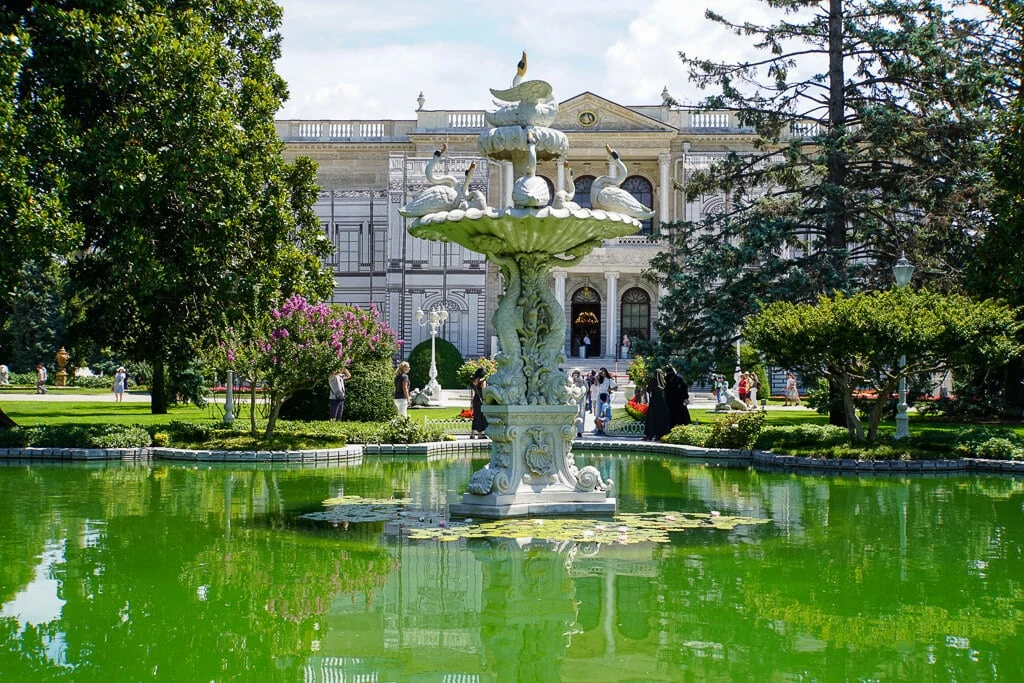
Dolmabahçe Palace is a must-see site when visiting Istanbul. Constructed in the mid-1800s on the European shore of the Bosporus Strait, Dolmabahçe Palace is an impressive Ottoman palace built as a more modern abode for Sultan Abdülmecid I to replace the former Topkapı Palace (another of the best palaces in Istanbul).
The name Dolmabahçe comes from the Turkish words meaning ‘filled-in garden’ and refers to the fact that a bay once stood at this point on the Bosporus for Ottoman anchorage but was filled in to create a relaxing garden for the Sultans of the Ottoman Empire instead.
The spectacular palace comprises of three main sections spread over the 250,000 square metres of grounds: The Administrative Apartments, the Ceremonial Hall and the Imperial Harem, along with multiple smaller out-buildings. It is the largest palace in Turkey containing 285 rooms, 46 hallways, 6 hammam baths and 68 toilets! The interior elements are opulent and exquisite and are Ottoman, Baroque, Rococo and Neoclassical in style.
While the ticket price is relatively expensive to enter the Dolmabahçe Palace, the rooms and interior decor are absolutely splendid, and the views and garden are excellent too. Your ticket price also includes an audio-guide tour to give you more information about the palace and its history as you walk around.
Please note, you can’t take photographs inside the palace or harem so please bear this in mind when contemplating whether to buy tickets to go inside.
Hattusha
Explored by James from The Travel Scribes

Photo Credit: Raddato / Flickr
Another UNESCO World Heritage Site to add to the ever-growing list of iconic Turkish landmarks, Hattusha (also spelled Hattusa) was the capital of the Hittite empire back in the Bronze Age, now another ‘forgotten’ city in ruins.
The city itself was said to have been founded as early as 2000 BC with the local Hattian people establishing a small settlement there. But it was the arrival of a Hittite king that really gave the city it’s prominence, as he established Hattusha as his residence and therefore capital, after which a prestigious line of 27 Great Kings followed in his footsteps.
The Hittite state collapsed around the Bronze Age and, with it, the city, as it was totally abandoned. It was only in 1883 that it was ‘found’ again, with the arrival of French archaeologist Charles Texier who discovered the ruins.
Nowadays you can still visit Hattusha and see what was once a captivating city close up. Notable for its 8 kilometre ‘city walls’, it also includes a number of small temples, the staggeringly beautiful ‘Sphinx Gate’ and the famous rock sanctuary of Yazilikaya, an open air temple with two chambers cut straight into the bedrock.
Ephesus
Explored by Carley from Home to Havana

Known the world over for its importance as one of the hubs of the early Christian world thanks to its eponymous book in the Bible, Ephesus is one of the most visited destinations in Turkey. It boasts the impressive Library of Celsus, one of the only remaining libraries constructed during the Roman Empire, and massive amphitheater thought to be the largest in the ancient world. While the Library and amphitheater are impressive, don’t miss some of the site’s less-visited gems, like the Temple of Hadrian and the Basilica of St. John.
Make sure you get here early if you can, as soon as the park opens at 8:00 am, to escape the afternoon heat and avoid the crowds, having the opportunity to enjoy this historic site nearly alone. For the best photos of the Library, hurry there are soon as the park opens and then backtrack to explore the rest of the ancient city’s sites as the park fills with visitors.
The surrounding area is also home to the remains of the Temple of Artemis, one of the ancient wonders of the world, though just a single pillar remains today. You also won’t want to miss the nearby house of the Virgin Mary, often overshadowed by Ephesus, but an important religious pilgrimage site, as many believe she lived here until the end of her life.
Perge
Explored by Lee from The Travel Scribes
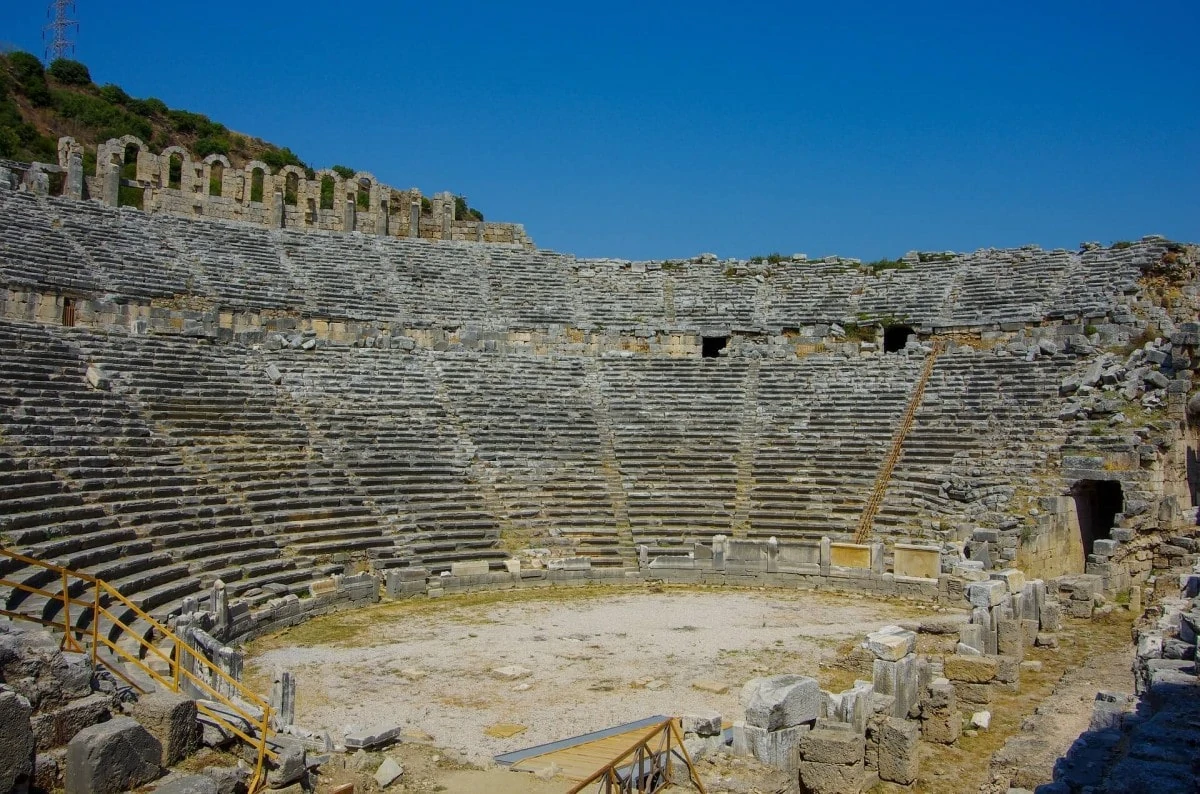
Perge (or Perga), is another one of Turkey’s ancient cities now in ruins. Said to have been built somewhere between the 12th and 13th centuries BC, it was ruled by the Persians and Athenians before surrendering to Alexander the Great and coming to the fore during Roman rule during the 2nd and 3rd centuries AD.
Like many of the ancient towns in Turkey, it fell into disfavour and later disrepair before being ‘reborn’ as a tourist location in modern times. Nowadays you can travel to Perge (about 15 kilometres from Antalya) to see some of the remaining structures, including the formerly glamorous basilica and baths, the impressive city walls and the stadium, one of the best preserved in the ancient world.
Aphrodisias
Explored by Noel from This Hawaii Life
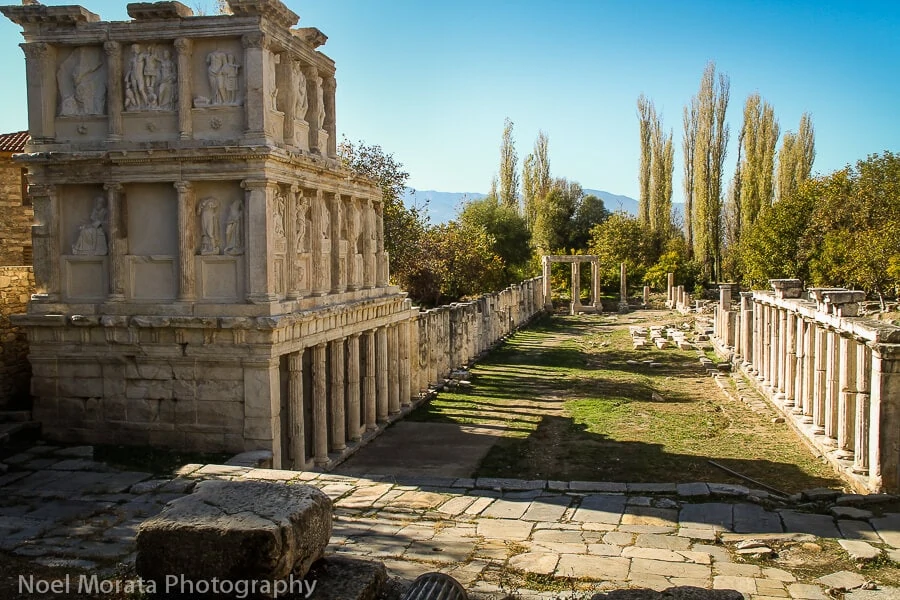
One of the most underrated and lesser known historic UNESCO sites in Turkey that is really spectacular and worth a visit is Aphrodisias. Located just a few hours bus ride from the other famous UNESCO site at Ephesus, Aphrodisias is a fantastic Hellenistic Greek city located in the Western Anatolia region.
Named primarily for the ancient Greek god Aphrodite – the goddess of love – the site is an amazing collection of historic architectural treasures including the Monumental Gateway, Temple of Aphrodite, the Bouleuterion, the Sebasteion, the Roman theatre, the stadium and so many other wonderful ruins to explore. Because of its remote location, many architectural details, sculpture and art where found among the ruins and are showcased in a spectacular museum that is a must visit.
Visits to the site can be done in a docent tour, DIY tour or just reading the many placards in various languages among the historic tourist attractions.
Getting to the site is done mostly through tour buses or taking your own independent ride booked to the site, it’s a little bit of a hassle but not so bad with a new highway connecting the city of Geyre to the large coastal city of Izmir in the west. You can easily book reservations and a tour direct from Izmir for a day trip to the site, but it is worth staying overnight to explore the more expansive site in detail for those that really love to see and enjoy a fantastic UNESCO World Heritage Site.
Alanya Castle
Explored by James from The Travel Scribes

Possibly one of the lesser-known landmarks on this list, the Alanya Castle is a medieval castle located on a rocky peninsula jutting out into the Mediterranean Sea. Surrounded by a 6.5 kilometre wall and over 140 watch towers, this impressive structure is one of the more prominent landmarks in this area of southern Turkey.
It’s said that the first foundations were laid back in Hellenistic times but only really came to fruition when the Romans and Byzantines ruled the region, as they saw the importance of the Castle to guard the harbour from pirates and, of course, foreign armies.
That said, the castle (and city) was conquered in the 13th century by Seljuk forces and, after this, it was primarily used for residential purposes until the present day. Today a trip to the castle is strictly for tourism as you can spend a few hours exploring the shipyard, arsenal and many former military buildings. Much of the castle area is entirely free, although you’ll need to purchase a ticket to get into the Inner Fortress and the Ehmedek Fortress.
Galata Tower, Istanbul
Explored by Džangir from Dr Jam Travels

Galata tower is located in the Galata/Karaköy quarter of Istanbul, north of the Golden Horn’s junction with the Bosphorus. This medieval tower was built in the 14th century by Genoese as Christea Turris aka Tower of Christ.
In the Ottoman period, it was renamed the Galata Tower. At the time it was built it was the tallest building in the city at a height of 67 meters. The external diameter is more than 16 meters and the inner diameter is almost 9 meters.
At first it was used for military defence, then later it was used as a tower for spotting fires in the city. Ironically it burned down twice.
After its last renewal in the 1960s, it was open to the public. On upper decks, you have an observation platform, restaurant and night club. A visit to the Galata Tower will set you back 35 Turkish Liras (approx. €4). Although a top tip is to pay a visit to this place at dusk. In the soft light and call to prayer from all the mosques, you will enjoy the south view of Sultanahmet across Golden Horn and north view of Taksim.
The tower can be reached from the north (Taksim) or south (Sultanahmet) on foot, by taxi, tram (south T1, north legendary red tram over Istiklal street), or Metro (Şişhane station on M2 line).
Aspendos Theatre
Explored by Lee from The Travel Scribes

About 50 kilometres east of alluring Antalya is the incredible ancient Greco-Roman town of Aspendos, with its incredible amphitheatre – definitely a must-visit landmark in Turkey!
This beautiful city was apparently founded around 1000 BC, becoming a flourishing trade town during the Roman period. However, like it’s neighbouring towns of Side and the afore-mentioned Perge, it fell into decline when silt made the harbour unreachable, and when the Byzantines favoured more centralised trade and distribution.
The most famous monument within the city still stands today – the Theatre. Built when Marcus Aurelius ruled the region (around 160-180 AD), it was founded during Roman rule but has many Greek characteristics, testament to its ancient Greek architect.
The theatre is impressively large in scale – 96 metres wide and flanked by huge stone towers; a must-see marvel when in this part of Turkey. And you can still visit it today, particularly during the Aspendos International Opera and Ballet Festival, which takes place each year in this amazing amphitheatre.
Grand Bazaar, Istanbul
Explored by Yukti Agrawal from Travel with me 24 x 7 blog

It’s one of the most famous markets in all of the world, the bustling Grand Bazaar in Turkey’s Istanbul.
This ancient covered market, which dates back over 500 years to its initial construction in 1455, is not just famous for its heritage – it’s also one of the largest covered markets in the world, spanning 61 streets, over 4,000 shops and attracting up to 300, 000 visitors every day.
Considered one of the first shopping malls on the planet, the Grand Bazaar is a great place to shop for Turkish souvenirs and handicrafts in Istanbul. Here you can see ancient style of handicraft that date back to more medieival times, as the market was a strategic trading point between Europe and Asia. With colorful artworks on display, you can get lots in the maze of textiles, food products and jewelry, amongst the many trinkets and goods on sale.
Open daily from 9am – 7pm, the Grand Bazaar is a must-visit landmark in Istanbul.
Basilica Cistern
Explored by Lee from The Travel Scribes

Did you know that under the heaving streets of Istanbul, there are hundreds of ancient cisterns, built because of insufficient water resources during the city’s dry summers? More than this, you can visit one of these incredible cisterns, beautifully constructed caverns situated far underground.
The most notable of the cisterns is the Basicila Cistern, located across the street from the Hagia Sophia, under what used to be – you guessed it – a Basliica named Ilius.
This amazing underground chamber is 143 metres long, and used to hold up to 80,000 cubic metres of water, transported to the city via aqueduct.
Nowadays the chamber isn’t filled with water, but with tourists. You can enter the cistern and walk through the cavernous location, boasting 336 soaring marble columns arranged in 12 rows of 28. It’s an astounding experience, hidden well below the streets of Istanbul, and undoubtedly one of the most interesting landmarks in all of Turkey.
Selime Monastery, Cappadocia
Explored by Lindsey from Have Clothes, Will Travel
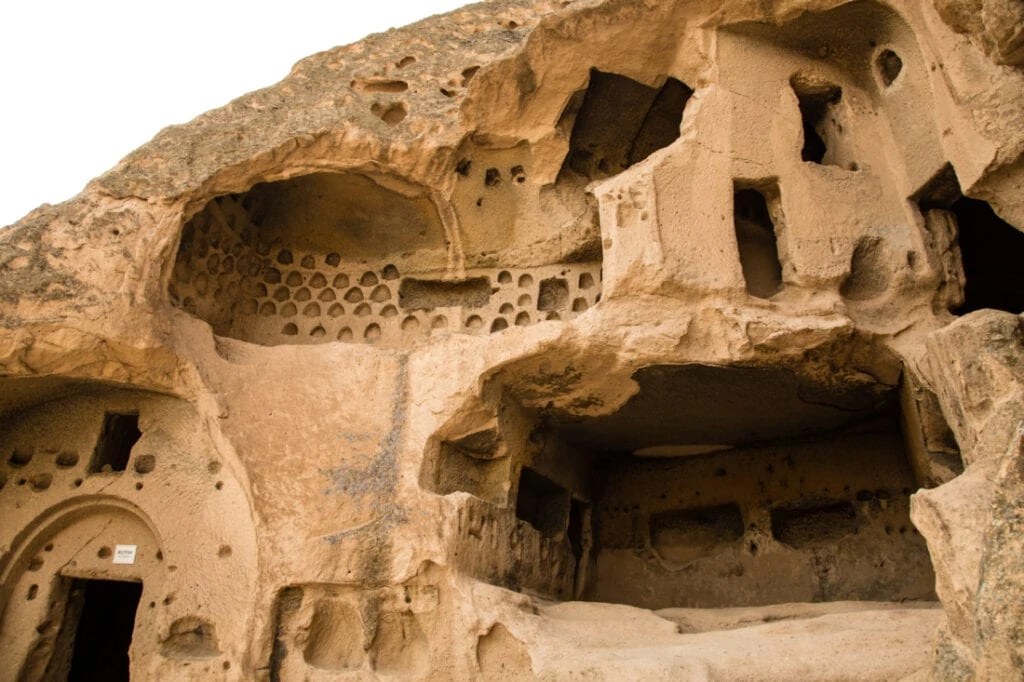
Selime Monastery is the biggest, rock-cut monastery in Cappadocia with a cathedral-sized church. Experts believe it took more than 200 years to shape the monastery, beginning in the eighth or ninth century, and it could house around 5,000 people! It is one of the best things to do in Cappadocia and one of my favorite travel memories from this trip.
It is a bit difficult to get to, however. You’re going to be hiking in some rather tricky spots. It is absolutely worth the workout, though! Not only is the structure itself impressive to explore, but it also offers some incredible views of Cappadocia once you hike to the top.
For Star Wars fans, this place looks like the planet Tatooine… where the Sand People live. And contrary to what you may hear around Cappadocia, Tunisia is actually where that scene of Star Wars was shot. Allegedly, George Lucas had wanted to film here in Cappadocia, but they were unable to get the proper approval to film in Turkey.
Selime Monastery is located 28 kilometers from Aksary, at the end of the Ilhara Valley. You could do a 2-hour hike from the Village of Ilhara through the valley, along the Melendiz River to get to Selime Monastery. Another option, and what I did, is to take the Green Tour day trip from Goreme to see Selime Monastery and Ilhara Valley.
Süleymaniye Mosque, Istanbul
Explored by Cate from Sacred Wanderings

The Süleymaniye Mosque is an incredible, massive Mosque in Istanbul that should not be missed on your trip to Turkey. The Mosque is located on a beautiful overlook above Istanbul, making it one of the best places to get photos of the whole city spread out below.
The Süleymaniye Mosque was built in the 1500’s and for a very long time was the largest Mosque in Istanbul. This Ottoman Era Mosque is free to enter and open daily. Aside from the main Mosque itself with its huge chandeliers, you can visit the Mausoleum of Suleiman the Magnificent, a beautiful circular structure with traditional columns.
The Süleymaniye Mosque is very near the Grand Bazaar and main shopping in Istanbul, a quick walk up the hill. Nearby are many hilltop cafés allowing you to get ice cream or a drink with a view! The Mosque also has public toilets that are clean and well-maintained. The park around it is lovely if you want to stop and read a book or just relax in the shade.
Derinkuyu and Kaymakli Underground Cities, Nevsehir Province

Explored by Heather from the Conversant Traveller
There are hundreds of underground cities in the Nevsehir Province of Turkey, formed from large caves excavated to house entire communities in times of strife, like during the Arab-Byzantine wars. The two most famous cities are Derinkuyu and Kaymakli, and visits to both can be easily incorporated into a day trip from destinations in Cappadocia like Goreme.
The cities once housed all the things needed by these communities to survive, including food and livestock. The main tunnels were closed off with heavy stone doors to prevent intruders from entering this subterranean haven, and there were wells that provided fresh water so inhabitants could survive for long periods without emerging above ground.
Derinkuyu underground city is the largest, dropping to around 200ft below ground with space for 20,000 people. Caves were on several levels connected by narrow passageways, with areas for different activities including living spaces, stables, cellars and even a wine press! Other rooms were used for schooling and a church was constructed so people could pray for deliverance.
Kaymakli was once connected to Derinkuyu by a warren of tunnels, linking the cities so information and resources could be shared. Nearly 100 passageways and interconnecting cave rooms were used as shelter from invading Muslim Arabs, Mongolians and Ottoman armies, and the city was only abandoned in 1923. The tunnels in Derinkuyu are a bit wider and less steep than those in Kaymakli, so if you want to take it easy on the knees, do take this into consideration.
So, did you love our list of must-visit monuments and iconic places in Turkey? Let us know if we’ve missed any important entries off the list, or if something in this countdown has changed by dropping us a note in the comments!
Alternatively, if you’re looking for some more legendary landmarks, you could check out some of our other landmarks pieces including:
- The best landmarks in Italy
- A list of our favourite landmarks in Croatia
- The 15 most famous Sri Lankan landmarks
- French landmarks you have to visit once in your lifetime
- All the most iconic landmarks in Germany
Want to save this for later? Why not pin it…


